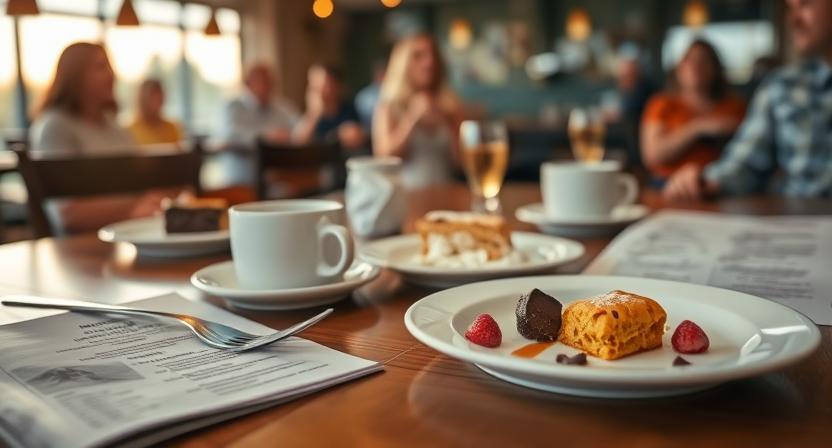Discovering the Art Behind a Recipes Restaurant Menu
More than just a list of dishes, a recipes restaurant menu is a well assembled experience that embodies creativity, tradition, and flavour. In today’s culinary culture, restaurants are evaluated not only on the basis of atmosphere or service but also on how effectively their menu reflects their claims. Creating a distinctive menu with original recipes is essential, regardless of whether you own a posh café or a little food stall.
Let’s talk about what makes a menu really unique, how choosing recipes is crucial, and how to create dishes that appeal to your customers’ tastes.
Why Every Menu Needs a Story
A customer is reading the history of your restaurant as they peruse the menu. It conveys your culinary philosophies, cultural background, and inventiveness. Every meal has a narrative, and these tales evoke strong feelings.
Menus with well chosen recipes draw repeat business. Customers receive more than just a meal—they receive a memory—when your dishes feature fresh, local food or reflect different cultures.

Balancing Innovation and Simplicity
It’s crucial for any restaurant to strike a balance between creative dishes and well-known favourites. Even while visitors enjoy trying new things, comfort food will always have a place. Provide recipes that are both familiar and daring.
Example: Serve spiced grilled chicken on toast with herb-infused aioli in place of a typical chicken sandwich. It doesn’t deviate too much from what people are familiar with while maintaining interest.
Seasonal Ingredients Keep Menus Fresh
One of the best ways to construct recipes is to use seasonal ingredients. It enhances flavour, lowers expenses, and demonstrates how your kitchen remains in tune with nature.
For example:
- Summertime: Feta salad with grilled peaches
- Wintertime: Rosemary and creamy pumpkin bisque
Seasonal updates also keep your regulars engaged. They return to see what’s new and enjoy limited-time options.
Signature Dishes Make You Memorable
Every successful restaurant has a dish that customers return for again and again. These signature recipes are what people talk about, recommend, and crave.
To develop a signature dish:
- Pay attention to the layering of flavours.
- Mix different textures (juicy, silky, and crunchy).
- Provide aesthetic appeal
One great signature dish can elevate your entire recipes restaurant menu and become the cornerstone of your brand identity.
Highlighting Dietary-Friendly Recipes
Today’s diners are diverse. Your menu should include options for:
- Vegan
- low in carbohydrates,
- free of dairy
Making completely distinct menus is not necessary for this. It involves ingeniously modifying your current recipes to appeal to a larger demographic. In this manner, no client will feel excluded.
For example, serve a traditional spaghetti version with a dish of zucchini noodles with sesame tofu. It’s an inclusive strategy that increases your attractiveness.
Pricing Strategies That Work
Customers’ choices may be influenced by menu prices even before the food is delivered. It must convey value without coming out as excessively costly.
Strategies include:
- Using odd numbers, such as 12.95 and 13.00
- To lessen the perception of price, remove currency indications.
- Emphasising high-quality ingredients to support the price
Prices should also reflect food cost and preparation time. A dish with aged cheese, rare spices, or specialty seafood deserves pricing that tells its worth.

Organizing Your Menu Layout
Design impacts what customers order. Use visual hierarchy:
- High-profit items should be positioned at the top or top-right.
- Use borders or boxes to draw attention to specials.
- Paint pictures with enticing explanations.
Menu Categories that Elevate Structure
Structure matters. Your recipes restaurant menu should have clear and engaging categories like:
- Appetisers: Add taste and stimulate hunger
- Mains: Highlight your culinary prowess
- Chef’s Specials: Emphasise new or seasonal dishes
- Desserts: End on a high note with decadent sweetness.
- Drinks: Choose revitalising combinations to go with meals.
Proper segmentation helps customers explore and builds anticipation throughout the meal.
Creating a Kid-Friendly Menu Section
Restaurants that cater to all ages are popular among families. It’s a good idea to include kid-friendly recipes in this section.
Some ideas:
- Tiny sliders
- Pasta shells with cheese
- Chicken tenders that are mild
Keep portions manageable and use fun names like “Little Bites” or “Tiny Treats.” It adds charm and boosts family visits.
Dessert Menus That Leave a Lasting Impression
Desserts provide the strongest impression, despite sometimes being the last course. Provide options that are both decadent and light:
- Cake with chocolate lava and vanilla bean ice cream
- Sorbet of citrus and fresh mint
Desserts also create upselling opportunities, increasing your overall ticket size.
Beverage Pairings: Boosting the Meal Experience
A well-chosen beverage enhances the whole eating experience. Every item on the menu can benefit from a suggested beverage, whether it’s wine, mocktails, or handmade sodas.
Example:
- Cucumber lemonade or white wine go nicely with grilled fish.
- Chilled mango lassi pairs well with spicy foods.
Add a beverage suggestion next to each dish to enhance satisfaction and increase sales.
How to Introduce New Recipes
New recipes keep your menu exciting. But launching them without a plan can confuse regulars. Use a system:
- Try recipes according to the season using limited-time offers (LTOs).
- Weekly Specials: Change up the menu to gauge demand.
- Customer feedback: Invite patrons to leave a comment or cast a vote.
By involving customers in the evolution of your menu, you build loyalty and ensure quality choices.
Keeping the Kitchen Staff Involved
A committed kitchen team is the backbone of every outstanding meal. Allow cooks to make recipe suggestions and provide feasibility input.
Benefits:
- raises spirits
- Encourages ingenuity
- simplifies the process of getting ready
When staff is involved, they serve dishes with pride—and customers feel the difference.
Menu Updates Based on Sales Data
Always track what’s selling and what’s not. Menu engineering allows you to categorize items:
- Stars: Highly profitable and well-liked
- Problems: Low popularity, high profit
- Plowhorses: Popular but low-profit
- Dogs: Unpopular and low-profit
Over time, use this research to improve your restaurant’s menu.

Leveraging Local Flavors and Heritage
Authenticity is added to your food by using regional ingredients or recipes. People identify with well-known, domestic flavours, whether they are found in regional crops or traditional spices.
Locally, a cuisine like grilled okra in tamarind sauce may evoke loyalty and nostalgia even though it is not a popular one.
Final Thoughts: Designing a Menu with Heart and Strategy
It takes both art and science to create a restaurant menu with well-crafted recipes. It is the intersection of branding, psychology, and taste. Your menu can become a potent instrument for expansion by concentrating on client demands, changing preferences, layout, pricing, and narrative.
